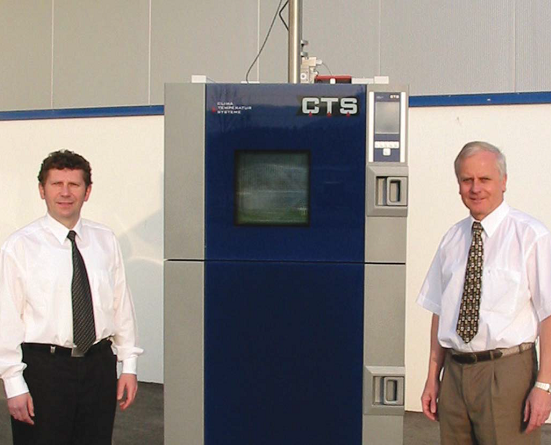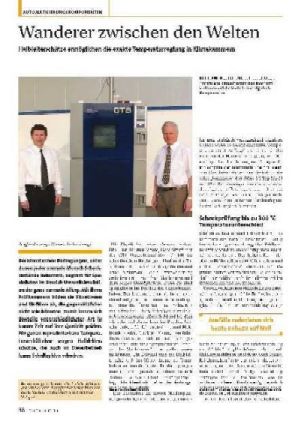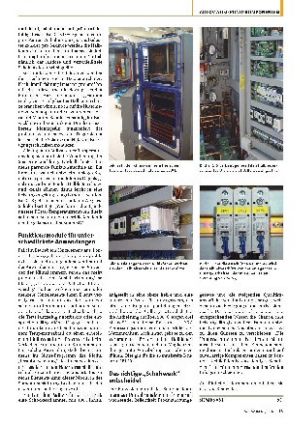Semiconductor contactors make possible the exact regulation of temperatures in climate chambers
March 2006

CTS Manager Helmut Maute (right) and Purchase Manager Udo Meerbott
Climate conditions under which any normal person would experience shock: this is how daily routine begins for environmental simulation specialists. They create situations and influences in their test chambers which could hardly be more different from one another. This allows the most diverse building components to be tested for quality in the shortest of times. Semiconductor contactors, which also allow short operation cycles, ensure precisely reproducible temperature conditions.
"Physics is our limit" emphasizes graduate engineer Helmut Maute, Business Manager of CTS Environmental Simulation GmbH in Swabian Hechingen. And truly, most jobs mean a tightrope walk between the technically feasible and the sheer impossible for him and his team. They are the experts in environmental simulation. That means that they simulate the most adverse environmental conditions such as heat, cold, climate, vibration, light, pollution gases or saline fog in appropriately built chambers. "The decisive factor is that we have a great deal of know-how in machine construction, process engineering and electronics" explains Maute. This signifies the consistent application of modern technology to further expand the boundaries of the possible. Take the Siemens semiconductor contactors, Sirius SC, for example. "Here we have had the best success; furnace outages are virtually reduced to nil as a result", confirms graduate engineer Udo Meerbott, Director of Order and Material Logistics.
The special thing about these low voltage semiconductors is that they work soundlessly and practically wear-free. They are especially suitable for switching tasks in furnace elements – precisely there, where the exact regulation of temperatures is so critical. "Our approach in the planning of our machines is the philosophy of the carry-over element", emphasizes Meerbott. This is why the company installs the Sirius SC type 3RF23 with a 20 A rated current into all of its chambers and doesn’t entirely exploit the graded range of products with a switching capacity of up to 90 A. "Normally we apply a 9 or 13 A load", adds Meerbott.
Shock tests with up to 300° C temperature difference
Approximately 400 such climate chambers leave the plant in Hechingen every year. The requirement situation often demands that a test chamber be built for especially extreme temperature differences. That means, for example, that a temperature of +200° C is prevalent in the upper half and in the lower perhaps -80° C. The shock test for affected building components comprises the cycled alternation of these components between the two extremes.
The process engineering as well as the machine construction must meet the highest standards for this. The temperature accuracy in the temperature-regulated area lies, depending on requirements, in the range of 0.1 to 1° K. Maute knows: "We can only achieve this with semiconductor contactors". With resistive loads, such as those which are experienced in this kind of application, the Sirius SC can be easily operated through the zero point switch. This has the advantage that the contactors are under minimal stress in this point, which automatically has a positive effect on their life expectancy.
The required amount of electricity is finely dosed through the length and frequency of operation depending on need. The impulse-pause ratio is in the range of 0.5 at CTS. More precisely, this means that the semiconductor relays are switched on and off once per second. This immediately highlights another advantage: namely the soundless and wear-free switching of these semiconductors.
The company in Hechingen has been using these semiconductor contactors for three years now. In their experience, it is a great advantage that these and the compatible heat sinks are exactly matched to one another. "The correspondingly constructed semiconductor contactors only need to be snapped onto the top hat rail and wired", reports Manfred Schuler, responsible for development and construction. This works without a problem because of the insulated mounting foot; the contactors can even be mounted on mounting plates with the help of fastening screws.
The important thing in temperature regulation is naturally the processing of the sensor response. That is why Siemens offers the appropriate function module. Thereby, a converter transforms an analogue signal into a pulse-width modulated digital signal. With that, the affected semiconductor contactors and relays can be easily integrated into a performance regulator. As Schuler confirms, a different approach is taken at CTS "We transmit the signals of our PT100 temperature sensors directly to our control and close the control circuit with the Sirius SC."
Function modules for the most diverse applications
Should a heating element cease to operate, the set temperature profile may become impossible to maintain and the user must react. Climate chamber operators usually take a pragmatic approach to this. "An outage sensor" says Maute, "is not necessary for our needs." Should it happen that one or several heating elements cease to operate, the operator will quickly notice a drop in temperature in the chamber. Then he can decide whether to terminate the tests or to continue them. On the other hand, in a production situation, the reaction time in the case of a temperature change can often have a significant influence on the process; for example in the gluing of multiple components. For such use cases, Siemens offers the ‘Load monitor’ module in the Sirius series that recognizes and signals – lightning fast – a heating circuit outage in the connected load circuit. The standard version of this module can monitor up to six elements – in the expanded version, twelve.
A typical assignment for CTS for example, is a shock test chamber with a capacity of 130 l, divided into an upper hot and a lower cold zone. An elevator system, driven by a ball screw, moves the test object up and down. Three Sirius SC semiconductor contactors with each 25 A rated current take care of the heating to over 200° C. The power connection comes from above, downwards to the load. With semiconductor relays on their own, there is also the possibility of running the entire cabling from above. This applies for the 45 mm wide construction model 3RF20.
The right 'pair of shoes' is decisive
The development and construction of environmental simulation chambers is enjoying growing popularity. Product liability laws and rising quality expectations of consumers are causing much worldwide movement in this niche market. This provides companies that possess the appropriate knowledge the chance to prove their performance and thereby to successively make the boundaries of the possible more favourable. "The prerequisite is", emphasizes Maute in conclusion, "to use the most modern of technology in all areas and to be able to construct using the most reliable of components". Ultimately, the right ‘pair of shoes’ is decisive for the success of the hiker amongst the worlds.
Siegfried Grupp und Markus Meier-Rampf
Detailed information is available under the code:
SIEMENS A&D 901
Authors: Siegfried Grupp is marketing officer and Markus Meier-Rampf is marketing promoter at Siemens AG Automation and Drives in Stuttgart
MSR-Magazin, edition 03/2006, p. 38
Vereinigte Fachverlage GmbH
Lise-Meitner-Straße 2, 55129 Mainz
Tel.: 06131-99201, Fax: 06131-992100





